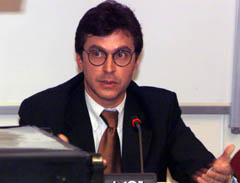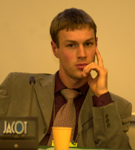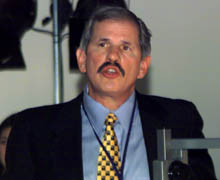|
|
||||
Monday 13 | Tuesday 14 | Wednesday 15 | Thursday 16 | Friday 17 | Saturday 18 | |
||||
|
Events convened on Monday 20 November 2000 |
||||
|
The
Kyoto Protocol and the WTO
Duncan Brack, RIIA Energy and Environmental Programme, identified three areas of particular complexity: · where States attempt to implement domestic standards which exceed those agreed internationally, for example, in domestic attempts to follow the precautionary principle; · where there is an attempt to make a distinction between production processes, on environmental grounds; and · where enforcement of an environmental regime involves a discriminatory trade action. Lucas Assunção, ICTSD, identified attempts to implement policies and measures (P&Ms) as a huge challenge, given the radically novel character of the Protocol compared to other MEAs. He said the WTO's Committee on Trade and the Environment had not taken account of the specific domestic mitigation measures to be made available by the Protocol, nor had climate negotiators addressed the trade implications of P&Ms. He envisaged that problems might arise if P&Ms came into conflict with trade rules on subsidies. Specifically, this could happen in areas such as energy efficiency standards, government procurement policies, and carbon taxes. Assunção pointed out that the WTO has some flexibility in its approaches both to subsidies and standards. Ali Dehlavi, ICTSD, looked at the compatibility of WTO rules and trade in ERUs, AAUs and CERs. He suggested that the functioning of the flexibility mechanisms may be undermined by trade rules, for example, in the likely scenario that some countries are excluded from participating in emissions trading. He anticipated violations of the "most favored nation" principle, the Subsidies and Countervailing Measures Agreement, and the General Agreement on Trade in Services. Concluding the panel presentations, Brack examined the potential conflicts caused by the Protocol's compliance mechanism. Summing up, he expressed some pessimism about the development of more coherence between trade rules and the Protocol and suggested that "without a crisis there may be no opportunity." Discussion: Discussants agreed that panelists were correct to identify standards and subsidy issues as the arenas for potential conflict between the Protocol and trade rules. However, the panelists were challenged to lower their levels of "paranoia" given the nature of the WTO, which is not a "self enforcing" regime but relies largely on the willingness of one or more members to initiate a complaint. It was suggested that complaints to the WTO arising from the Protocol may not be as frequent as some envisage. More information: |
||||
|
Quantifying Kyoto:the impact of COP-6 decisions on
the market
Michael Grubb, Imperial College, London, outlined the uncertainties surrounding the different models that were examined. He said that these models show different levels of energy and carbon growth, and projections from the global economic models rarely match those reported in FCCC National Communications. He argued that the extent of flexibility needs to be balanced in setting the rules for implementing the Kyoto Protocol. Discussion: Discussion focused on data sources, the carbon intensity of the Russian economy, supplementarity, and the economics of credits generated through the CDM. More information: |
||||
|
Climate Change and the World Bank
Lars Vidaeus, World Bank, introduced speakers on the Bank's involvement
in climate change issues. He affirmed that climate change is core to its
mission to improve quality of life and poverty alleviation through
sustainable development and equitable growth. Ajay Mathur, World Bank,
outlined the Bank's climate change activities, including: the World
Bank-Norway AIJ Programme; the Prototype Carbon Fund (PCF); National
Strategic Studies (NSS); environmental strategy for the energy sector; the
WB/GEF strategic renewables partnership; and the CDM Assist, a
collaborative programme to build capacity in Africa. Peter Kalas, World
Bank, described the National AIJ/JI Strategy Studies (NSS) as a mechanism
to enhance technical knowledge among host countries. He described NSS as
providing options on international markets and other financing
opportunities for GHG emissions offsets. Charles Feinstein, Energy Sector
Management Assistance Programme (ESMAP), World Bank, described a joint
UNDP/WB global technical assistance programme that provides innovative
solutions to governments and the private sector focusing on pre-investment
activities. He announced the allocation of $750M a year over the next five
years to support rural renewable energy and energy efficiency projects as
part of the World Bank Group - GEF Renewables Strategic Partnership.
|
||||
|
Turning the promise of technology into reality A number of initiatives on breakthrough technologies to address climate
change mitigation were presented at this workshop. Lynn Schloesser,
Eastman Chemical, explained that the Business Roundtable (BRT) is an
association of chief executive officers of leading corporations who are
concerned about climate change and committed to effective action. More information: |
||||
|
Partnership for Climate Action
Fred Krupp, ED, noted that the PCA members' combined emissions are equivalent to those of the country ranked 12th in the world for its GHG pollution. Total emissions in 1990 were 330M tonnes of CO2 equivalent, and total cuts pledged under the PCA would amount to 22% of this figure. Thomas Jacob, DuPont, noted that most of his company's reductions would be non-CO2 related. Thierry Berthoud, Pechiney, emphasized that much can be learned from shared experience. One such opportunity lies in setting up emissions trading systems between the companies, and thus demonstrating the viability of market approaches to the mitigatation of GHG emissions. Discussion: An extensive discussion followed. On lessons for an international trading regime, BP advocated setting up an exchange where allowances can be traded rather than using bilateral arrangements. In addition, BP believes that liability for the integrity of a trade should lie with the seller because this will improve confidence in the market. On the practical implications of the PCA on current negotiations, panelists stressed that this private effort has just taken off and much needs to be learned and further defined. On the issue of leakage, Anita Burke, Shell, remarked that this underlined the need for transparent accounting rules. She noted that Shellis already incorporating the carbon implications of new investments and is adjusting its business portfolio to reflect a carbon constrained future. Panelists stressed that the PCA does not lobby the United States Congress, and that most of its focus is related to learning by doing. In concluding the event, Fred Krupp, ED, argued that a carbon constrained world is highly probable and that companies need to be prepared to operate under such conditions. More information: |
||||
|
Engaging the private sector in the CDM: David Moorcroft, WBCSD, presented work carried out in cooperation with several United Nations agencies to construct a platform for commercially viable CDM projects. He discussed the need to assess the business context of potential projects and to develop an effective system of knowledge management to avoid "parachuting" experts into the field to carry out projects. Energy Indicators in IEA countries and beyond
More information: |
||||
|
Flexibility mechanisms: an opportunity for sustainable development André Maïssieu, WONUC, invited participants to ask questions about nuclear energy. Responding to a question on nuclear waste, he criticized the anti-nuclear lobby and presented an example of waste storage. He announced WONUC plans to organise a conference on this topic in 2001. |
||||
|
Operationalizing the Clean Development Mechanism: accreditation, conformity assessment and standardization issues
Opening the event Viktor Kaisiepo, West Papua Peoples Front, invited panelists to discuss the issue of defining a forest. Hendro Sangkoyo, Consortium for Community Forest Systems, stated that the forest definition proposed by COP-6 will result in the commodification of forests and threatens serious social and ecological implications. Johnson Cerda, Coalition of Indigenous Organizations of the Amazon Basin (COICA) and Amazon Alliance, expressed concern about recent government interest in defending the Amazon for its carbon value, noting that Indigenous Peoples have been protecting forests for centuries. He noted that Indigenous Peoples seek greater formal participation in international negotiations. Kalimba Zephyrin, Communauté des Autochtones Rwandais, said that forests represent "life" for indigenous groups in Africa. Chris Webster, Representative of the Maori Congress, expressed concern that treating forests as a commodity threatens Maori spiritual links and territorial rights to forests. More information: |
||||
| |
|
| © 2000, IISD. All rights reserved. |
|








